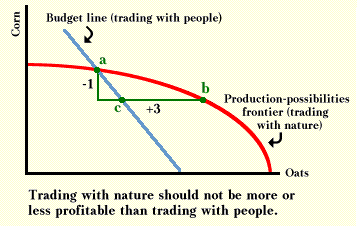Product-Mix Efficiency
Even if an economy is on its production-possibilities frontier, it may not be economically efficient. Not all points on the production-possibilities frontier have the same value. Hence, to be economically efficient, an economy must find that point on its production-possibilities frontier or that mix of products that has the highest value. This final condition of economically efficiency may be called product-mix efficiency.
For an economy to have product-mix efficiency, "trading with nature" must have the same "price" as trading with people. If an economy is on the production-possibilities frontier, then more of one good, good A, can be produced only by shifting resources and thus producing less of something else, good B. The slope of the production-possibilities frontier, which economists call the marginal rate of transformation, shows how much of good B must be given up to produce more of good A. When society moves along the production-possibilities frontier, it is trading with nature, and the marginal rate of transformation is the price it pays to get more of good A.
The amount of good B that must be given to people so they willingly give up a unit of A must be the same for all people if the economy is exchange efficient. The ratio at which people will trade B for A is the marginal rate of substitution. Only when the marginal rate of transformation of each product is equal to the marginal rate of substitution, that is, when "trading with nature" has the same "price" as trading with people, will the economy be economically efficient.
A numerical example makes this condition easier to understand. Suppose that producing one more bushel of corn requires the sacrifice of three bushels of oats. This statement tells us how the economy can trade with nature. Also suppose that people value corn and oats equally, that is, they will trade a bushel of oats for a bushel of corn. Even if the economy is production and exchange efficient, which means that it is on the production-possibilities frontier and that given the amounts of corn and oats produced, all mutually advantageous trades have been made, there are changes that can increase value. If one less bushel of corn is produced, three more bushels of oats can be produced. Because a bushel of corn and a bushel of oats have the same value in the eyes of consumers, the sacrifice of one bushel to get three is a desirable sacrifice. Hence this shift will increase value and thus efficiency.
The graph below illustrates the discussion of the previous paragraph. Both point a and b are on the surface of the production-possibilities frontier. Moving from a to b means a loss of one unit of corn and a gain of three units of oats. Points a and c are on the same budget line. The slope of the budget line depends only on the relative price of corn and oats, and all points on a budget line represent equal expenditures of money. Thus, point a is valued the same as point c. Because a move from a to c leaves consumers with the same value (because they consider a loss of a unit of corn as exactly offset by the gain in the unit of oats), a move from a to b would increase value. (You should be able to see that one can also argue that point b is better than a by referring to the marginal costs and marginal benefits of the move.)

A move from a to b in the graph above would change the marginal rate of transformation (the slope of the production-possibilities frontier). It might also change the marginal rate of substitution (the slope of the budget line). As the economy slides down the production-possibilities frontier, the slope of the production-possibilities frontier should get steeper, and the slope of the budget line flatter (because oats should get cheaper relative to corn as people get more oats and less corn). When the two curves have equal slopes, the budget line will be tangent to the production-possibilities frontier. Here, the marginal rate of transformation equals the marginal rate of substitution and this point is economically efficient.
An optional section discussed the possibility of inefficiency from producing too much or too little bread. This inefficiency is caused because the marginal rate of transformation does not equal the marginal rate of substitution. Important cases of product-mix inefficiency occur when markets have monopoly or externalities.
We finish the unit with some reservations about economic efficiency.
Copyright Robert Schenk